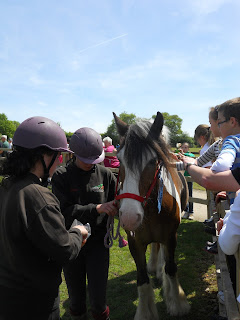A few years ago my parents gave me the great birthday gift of adopting Finnegan at Redwings Ada Cole Visitor Centre in Harlow, Essex. Since I still haven't achieved my life-long ambition of having my own horse, Finnegan is a lovely substitute and I enjoy visiting him when I can.
Last Saturday was his 17th birthday and everyone who had adopted him was invited to celebrate his birthday the day after. On the Sunday I took my sister and my boyfriend Conor's two second cousins Macaela and Enya along with me and we all had a great time seeing all the different horses at the centre. However no attention escaped from Finnegan, after all it was his big day!
At 1pm we all gathered around to sing 'Happy Birthday' to Finnegan at his special birthday parade and the carers then slowly brought Finnegan and Henry round to see everyone. We all gave him plenty of fuss on his big day and it was really nice to see how many people turned up to celebrate with him.
It's not just people who can have birthday cake either! Finnegan got to enjoy a scrumptious birthday cake made especially for him. The carers had soaked some pony cubes and then moulded them into a cake-like shape before adding polos, apples and ginger nut biscuits. Henry was also lucky enough to enjoy his own cake too so he wouldn't feel left out. As you can see, they both eagerly tucked in!
After the parade we had our picnic before making our way round the rest of the centre. There are quite a few fields to walk around with plenty of horses to look at and it's a great day out for all the family to enjoy. I even pretended to be a horse for a while to help entertain Enya, which I have to say I quite enjoyed!
At 15.2 hands, Finnegan is a handsome coloured cob who was rescued by the RSPCA along with two other horses, one being his best friend Henry. Found in London, all three were very neglected and thin but have made a full recovery with the help of Redwings. However, he is known as a 'good do-er' meaning his weight will need to be constantly monitored for the rest of his life to prevent him for developing any weight-related problems such as laminitis.
Celebrating 25 years of caring, Redwings is one of the UK's largest horse sanctuaries and and cares for more than 1,300 horses, ponies, donkeys and mules. Funded entirely by donations, their visitor centres include: Ada Cole Rescue Centre in Essex, Caldecott Visitor Centre in Norfolk and Oxhill Visitor Centre in Warwickshire. For more information visit www.redwings.org.uk

Factfile:
- Cobs are a sturdy animal known in the Medieval times as a rouncy or roncey
- The ideal cob stands from 14.2 to 15.2 hands high (hh), has a thick crested neck, a short back with a deep girth, rounded highquarters, short legs and hard, round feet.
- They can be any colour and has a generally smooth and comfortable gait.
- Usually safe and extremely strong, their unruffleable temperament is in high demand.













































.JPG)

